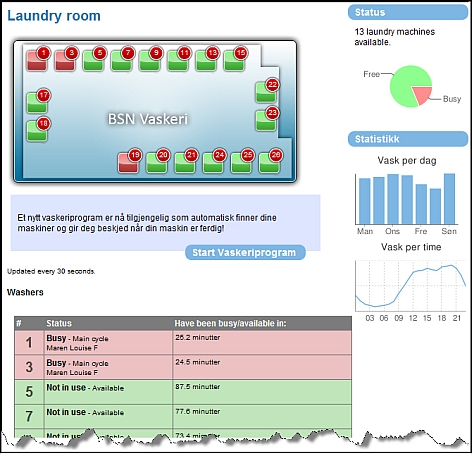Enterprise student laundry system fails

Disclaimer: This story is based on unverified facts, so no parties are identified. Nonetheless, the situation remains interesting and instructive.
As part of a cost control and accounting implementation, a major European university installed networked laundry machines for students. Read on to see why this failure is destined for the record books.
Light-hearted technology failure website, the Daily WTF, describes the situation [edited]:
Step One: Your Laundry Account. Go to your nearest laundry, insert your card, and a receipt with your username and password will be printed. It didn’t take too long for the small box printing receipts to run out of paper, [so] students couldn’t do laundry.
Step Two: Login Fails. For the few lucky who were able to get a username and a password, the next step was to log in to a web-based system in order to prepay for using the laundry. For the user’s convenience, the username consisted of 20 uppercase letters and was case sensitive.
Step Three: Install the Required Updates. As the login problems spread frustration among the poor inhabitants, the university was helpful enough to compile a how-to guide for logging in [that] only worked in Internet Explorer. In addition, the helpful guide showed you how easy it was to install the required updates/patches on your computer needed to do your laundry. Slowly, the inhabitants were able to access their laundry accounts, except of course for Mac/Linux users.
Step Four: 8.333333 Machines, Please. The pre-defined amounts you could choose [in the web-based application] from was not dividable by the cost of a single machine use, leaving many to wonder how to spend the last .333333 washes. A payback system [let students] get their remaining $0.566772 transferred back to their bank accounts.
Step 5: Reservations: Blocking the Machines. The web-based system let you reserve a machine for a certain time (though washing without a reservation was still possible).
Let’s say a machine takes 1 hour, and I reserve it from 12:00. This means that after 11:01 nobody could start a new machine, as it would crash with my reservation. On average, this would cause a half hour idle period for each reservation, or a 50% drop in efficiency. This of course assumes that you actually use your reservation. If not, you simply blocked the machine for an hour or two for those who needed it.
Step 6: Profit? To this day, students are still stuck with the nightmarish system. Some new habits have evolved, such as learning how to renew the washing machines’ IP addresses by disconnecting and connecting the network cable whenever there is a “network error” on the machines’ displays.
THE PROJECT FAILURES ANALYSIS
The basic principles for successful enterprise implementations are universal, regardless of specific application, type of business, technology vendor, and so on. These fundamental truths include:
- Creating a business case that defines why the new technology is an important and worthwhile investment
- Involving users in system design to ensure the system meets their needs
- Testing the system thoroughly, to be certain it works as planned
The extent to which the software designers and implementation consultants violated these principles is extraordinary. Top enterprise blogger, Zoli Erdos, believes the system was:
created by unqualified third party integrators who probably did not bother to talk to real students and try to imagine their daily life, including laundry.
If you're interested in seeing a real-time, network-connected laundry system, click over to the Norwegian School of Management. Here's a screen capture:

In contrast, this MIT laundry room uses a text-based interface to display information on machine availability:
My favorite laundry room monitoring system is LaundryView. The display includes vibrating machines and 3-D rotation that users can control. Check it out.